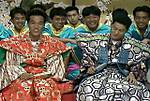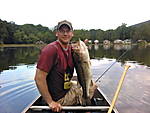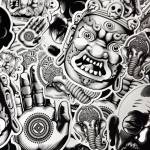Hey guys,
Thanks for the funnies. Here's another.

Ok, so on to washes now. Remember all of those future coats we laid down? Well they will come into handy with the next steps. I cannot stress enough how important a good gloss surface plays in washes. You don't want to have your base coat lift on you, it is a real pain to fix.
Putting my old MM enamels to use.

I tilt my wash cup ever so slightly. I also like to have a few colors at once. I still end up performing a few washes, but I like the flexibility in colors as I go.


One of the benefits of tilting the cup is it allows me to determine how thick / aggressive / sluggish my wash is. If I pick from the top of the jar, the wash is likely to be thicker.


And if I pick lower in the jar, I get a thinner application. I also decided to take the lighter of the color in the mixture.


Note the differences in thickness and left-over marks.

OK ok, so now I apply the wash to the model. I tend to play a little thicker / wetter. I wouldn't consider this a "sludge wash" as others would say, but it is pretty close.
Note, the color of the wash was too light. I had to redo the model in a darker color, but you get the idea. I think this shade would have been perfect for a desert vehicle.





Ok, so now that the wash is applied and dried, you have to shape it how you want. You can streak it, smear it, or have it only show in the recesses as a "pin wash". Again, be random in the patterns. If any patterns catch your eye, break it up.




The circle around this post is too uniform.


There, that's better.

Ok, so now I want a little streaking effect with the wash.



Again, you shape the wash to do what you want. Just because you intended the wash to act like a "pin wash" doesn't mean you can't change it here and there if it looks really cool doing so!
Ok so away from the camera, I finished cleaning up the lighter wash. I then applied a thinner, darker wash. The original wash was WAY too light.
When looking at these images (and when you are applying your washes), don't get too hung up on things looking really streaky. The wash drys to a dull finish, whereas the undercoat is glossy. If you are seeing all sorts of weird lines that won't clean up, it is probably because of this. The final flat coat will bring everything to an even sheen and remove the streaking.
These next few photos are the only correctly exposed photo's to give you a sense of how dark I think panzer grey should be. The rest are overexposed to show the weathering.



And now the over-exposure shots.
















Well, it is turning out a little dirtier than I had intended. I wanted to depict this vehicle during some troop trials / factory testing. It is still a little too dirty for that.
I'll keep the dry-brushing and chipping to a minimum. Again, the actual color of the vehicle is very dark, so much of the efforts shown will be very subdued.
Thanks again for tuning in and all of the nice comments. People really seem to like the in-action shots. Hopefully it is helpful on your own models. My techniques are just one of the many ways to complete a model.
For the photo today, I had a small rez Normandy dio of a Marder I. For some reason I like the setting.













































































































































































































































































